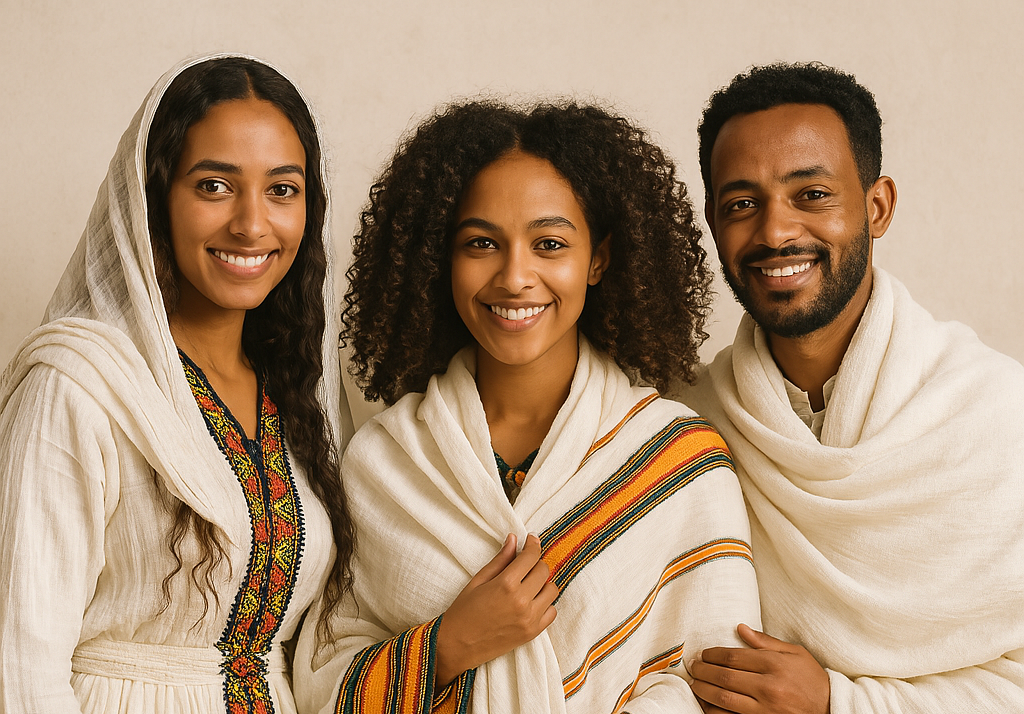Ethiopia, a country known for its rich cultural history and diverse traditions, has always been a place of pride and beauty. Among the many aspects of Ethiopian culture, traditional clothing holds a special place. Whether you're attending a celebration, festival, or simply want to embrace the beauty of Ethiopian heritage, wearing traditional garments like the Habesha Kemis, Netela, and Gabi can transport you to the heart of Ethiopian culture.
In this blog post, we'll dive deep into the world of Habesha style—understanding the significance, history, and unique elements of these beautiful garments.
1. The Habesha Kemis: A Symbol of Elegance and Heritage
The Habesha Kemis is perhaps the most iconic piece of traditional Ethiopian clothing. Worn by women during special occasions, celebrations, and festivals, the Kemis is a stunning dress that blends simplicity with elegance. Made from cotton, it features intricate hand-embroidered designs, often around the collar and sleeves, adding a touch of artistry to the garment.
Cultural Significance:
The Habesha Kemis is not just a dress—it's a symbol of identity and pride. Traditionally worn during important ceremonies like weddings, religious holidays, and cultural festivals, the Kemis ties women to their roots and showcases their connection to the country’s rich cultural heritage.
Design Details:
The beauty of the Kemis lies in its design. While it is often white, the garment can feature vibrant colors, especially in the embroidery. The use of gold, red, green, and other earthy tones is very common, representing various aspects of Ethiopian culture, including its history, faith, and natural landscapes.
How to Style the Kemis:
To complete the look, women often wear a Netela (a sheer scarf) over their shoulders, which can be draped elegantly or tied in different ways depending on personal style.
2. The Netela: A Versatile Scarf for Every Occasion
The Netela is an essential accessory in Ethiopian traditional attire, often worn alongside the Habesha Kemis. This lightweight scarf is usually made from cotton or a mix of cotton and silk, and it can be draped around the shoulders or wrapped around the head for a more formal or modest look.
Cultural Importance:
The Netela holds cultural and religious significance, particularly in Ethiopian Orthodox Christian traditions. It is worn as a symbol of respect, especially when entering churches or attending religious ceremonies.
Versatility:
One of the unique aspects of the Netela is its versatility. It can be worn by both men and women, and it can be paired with modern or traditional outfits. Whether it’s draped over the shoulders or tied into a headscarf, the Netela adds a layer of elegance to any outfit.
3. The Gabi: A Woven Masterpiece
No traditional Ethiopian wardrobe is complete without a Gabi—a large, handwoven blanket that is often worn during cooler weather or for ceremonial purposes. The Gabi is an incredibly versatile garment and can be worn as a shawl or draped over the body as an outer layer.
Traditional Use:
The Gabi is most commonly worn during religious festivals, such as Timkat (Ethiopian Epiphany) or Meskel (Finding of the True Cross). It’s also worn by elders or community leaders as a symbol of respect and dignity.
Handwoven Craftsmanship:
What makes the Gabi so special is the craftsmanship. Skilled artisans hand-weave each piece using natural fibers like cotton and wool. The process takes time and dedication, making the Gabi not only a beautiful garment but also a piece of art passed down through generations.
Style and Comfort:
Despite its heavy appearance, the Gabi is surprisingly comfortable. It’s designed to be warm, making it perfect for chilly nights, yet light enough to be worn throughout the day.
4. Embracing Habesha Fashion in Modern Life
While these traditional garments are deeply rooted in Ethiopian culture, they’ve also found a place in modern fashion. Designers and artisans are now incorporating Habesha clothing into contemporary styles, making them more accessible and stylish for daily wear.
From wearing a Habesha Kemis at a wedding to incorporating Ethiopian-inspired jewelry into casual outfits, there’s no reason not to embrace Habesha style in every aspect of life. In fact, many people are discovering how beautiful and meaningful these garments are and are choosing to wear them not just for special occasions but for everyday moments.
How to Incorporate Traditional Ethiopian Pieces into Your Wardrobe:
-
Pair a Habesha Kemis with a modern jacket or leather boots for a chic, hybrid look.
-
Wear a Netela with a dress or blouse for a touch of elegance in your casual outfits.
-
Add Ethiopian jewelry like silver bangles or beaded necklaces to complement your traditional attire.
5. Explore Our Collection at Habeshalist
At Habeshalist, we’re proud to offer a curated selection of traditional Ethiopian clothing and accessories. Our collection includes beautiful Habesha Kemis, intricately embroidered Netelas, and elegant Gabies, each piece crafted with care and rich in cultural significance.
Whether you’re looking to embrace your heritage or explore the beauty of Ethiopian fashion, we invite you to discover our store’s carefully selected items. Each piece tells a story, and we hope that it brings a little bit of Ethiopia into your life.
Shop Now to explore our collection and experience the elegance of Habesha style!

